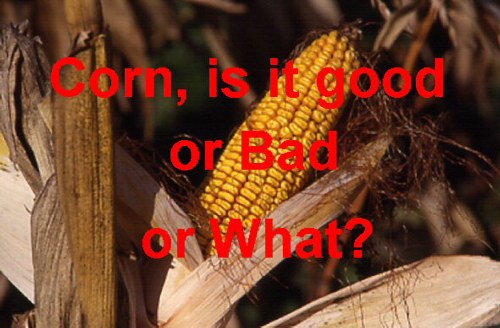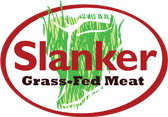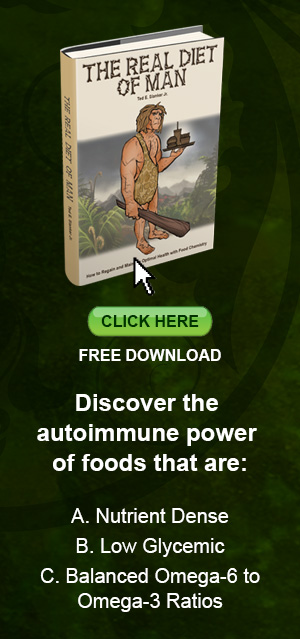Corn, It's What's Bad for You
This is a very big story about Corn's Nutritional Value.
Corn is a seed produced by an annual grass plant. It is similar to the seeds produced by these other popular annual grasses: wheat, oats, barley, rye, rice, etc. The harvested seeds from these annual grass plants are called grain. Basically all of them have the same negative nutritional values as corn in only slightly varying degrees. Therefore none of them are fit for human consumption! Here is why.
The Omega-3 deficiency in America's food is primarily due to grains, oils from grains and nuts, and some other foods made plentiful by inventive agricultural pursuits. But that is only one of the many nutritional imbalances found in grain.
 This article about corn's nutritional value (first version written in 1999) only introduces the story about what is wrong with America's food. It is a big story involving all grains, whole grains or milled grains, organic or not. It is not common knowledge. Yet nutritional scientists have been pounding the table with this story since the late 1970s. On this Website there are many additional articles and sources of peer-reviewed scientific reports that clearly illustrate how the chemical composition of grain is foreign to all animal bodies. The initial research dates back to the 1970s!
This article about corn's nutritional value (first version written in 1999) only introduces the story about what is wrong with America's food. It is a big story involving all grains, whole grains or milled grains, organic or not. It is not common knowledge. Yet nutritional scientists have been pounding the table with this story since the late 1970s. On this Website there are many additional articles and sources of peer-reviewed scientific reports that clearly illustrate how the chemical composition of grain is foreign to all animal bodies. The initial research dates back to the 1970s!
Today, the "only reason" you hear so much about Omega-3 Fatty Acids is because grains are deficient in this most important essential fatty acid. Our nation's food system is based on grain. Therefore our nation's food system is universally deficient in the essential Omega-3s. That nutritional deficiency alone is linked to nearly every known chronic disease and chronic diseases are body failures. Learning how to measure that deficiency is critical to human health.
The Omega-3 deficiency is not grain's only nutritional deficiency. On average grains have only 65% of the known nutrients required to support optimal body and brain function. Grains are also dangerously high glycemic. For all of time the animal kingdom had the green leaf at the bottom of the food chain. Not seeds. For instance kale has 100% of the required nutrients, a perfect balance of essential fats including the Omega-3 fats, plus it is low glycemic. This is why animal bodies (people, dogs and cats, and livestock) are not geared to build and maintain themselves with nutritional values of grain. That's why the nutrients and mycotoxins from grain are literally causing an epidemic of chronic diseases that strikes all people and even their pets in time.
Because of this understanding about grain's shortcomings as a food, the USDA changed its Food Pyramid (it's now My Plate) and took grain off the foundation and demoted it by making it one or the four servings on the plate. In time, grain will be completely removed from the plate. See Best and Worst Foods.
At the cell level, animal bodies (which include human bodies and dogs and cats) must follow the nutrient and essential fatty acid profiles of green leaves in order to have optimal body function. (For more about the world's foundation food for all animal life read In the Sea and Green Leafy Plants.) Grain, the seed of an annual grass plant, does not offer that nutrient profile. In addition, grain is universally contaminated with fungi. Fungi put out mycotoxins and those mycotoxins are the most abundant toxins in our nation's food system. To better understand this concern read this terrific scientific-based focus on mycotoxins. There are many more like that! So check them out along with other links on the sidebar of this page for additional information.
Corn, It's What's Bad for You
Instead of “Beef, It's What's for Dinner,” I thought my title might be better. Today, the American diet is not balanced. It's heavily weighted with grain, grain-based food products (foods and drinks laced with high fructose corn syrup and other grain-type additives), and grain-fed livestock products. Back in the late-1970s scientists started discovering that grain, grain-based foods, and grain-fed livestock products are the root cause for most if not all of today's major chronic diseases (body failings): Cancer, depression, obesity, allergies, autoimmune diseases such as lupus and arthritis, diabetes, asthma, and the list seems endless. (For additional articles documenting the reasons why grains are damaging to animal body function go to OMEGA-3 ESSAYS.)
Amazingly, the worst grain is corn! And wouldn't you know it, corn is the most abundant grain produced in America! Not only does it have the worst fatty acid profile (Omega-6 to Omega-3 ratio) of nearly all grains (which skews the fat balance in the membranes of all animal body cells negatively impacting cell function), but it is also a fungal host to 22 different fungi including Aspergillus. Some of these fungi put out body debilitating mycotoxins that can literally kill animals and people. This is why the US Government tests corn for aflatoxin, one of the most deadly and highly carcinogenic toxins on the planet. Many condemned corn supplies end up in animal feeds (not only for livestock in feedlots but family pets too.)
One would think that everyone would be lit up like downtown lights in their attempt to eat right. Therefore, getting the word out on modern fatty acid research, which started coming out in the mid-1970s, should be a snap, right? Wrong! American business is Big Business. That means it is entrenched with huge capital investments in fixed assets and magnificent cash flows from daily sales. It currently feeds 300,000,000 Americans three meals a day, therefore it is fully committed to the status quo. And worst of all, their customers resist change and continue to vote with their dollars for inexpensive grain-based foods. That makes it nearly impossible for large businesses to promote radical change.
Yet maybe even far more sinister (if that is the right word) is the advice our nation's medical practitioners hand out to their patients. For the most part the medical profession knows next to nothing (mostly what it knows is common knowledge) about nutritional science. For sure they do not understand how the Omega-3 fatty acid deficiency occurs,it's implications, and how to eat naturally in order to have a perfect fatty acid profile which will prevent body failure (chronic disease). Consequently they never cure their patients' chronic diseases, they merely help them live with their health problems (or under the threat of recurrence) courtesy of drugs and operations.
For a small-time example of entrenchment, I had a fellow from a feedlot respond to one of my e-mails about grass-fed beef. His testy answer was full of indignation. He told me to “pay attention,” in other words, he's a feedlot man so why would he even want to hear about grass-fed beef.
I laughingly thought to myself, now here is the big-time stagecoach builder responding to a notice by the upstart Henry Ford. At least I hope that's the case. That happened back in 2000 give or take a year.
Since I am in the grass-fed meat business you can see I have faith in the ability of folks to change the status quo. The right products will win out over time. The truth always prevails in time. The negative stories about corn and other grains will continue to come out. And what is today religion on one hand and sacrilegious on the other will slowly change. As it does, industry will change. Some big companies will wither and die. Others will make the required changes. Some new upstarts will win the day. Some will fail along the way. That's how the free market system works. It's not perfect, but it eventually gets the job done better than any other system.
No, Not Corn Again
I found an article in the Texas Polled Hereford Association News that was originally printed in the Louisiana Cattlemen. It was by Dr. Todd Duenckel, DVM. He said he had a call last winter from a stressed-out rancher. The man reported that he had several yearling calves that were down and they wouldn't get up. The vet rushed over expecting to see some pretty severe pneumonia cases.
When he arrived, the calves were perky and bright eyed. They looked healthy, except they wouldn't get up. On closer examination he discovered they all had broken legs or hip bones. He immediately suspected the diet. The rancher told him that 30 days earlier he had switched from dairy pellets to straight ground corn and nothing else. Immediately the veterinarian knew the “disease” the calves had was a form of “rickets,” or calcium deficiency. Corn is tremendously deficit in calcium. He also stated that adding soybean meal to the corn ration could have intensified the problem! With the extra protein the calves would have grown faster, further stressing their weak bones.
Then he described two more ailments caused by corn screenings. One is acidosis, which is a severe increase in stomach acidity that can be fatal. The other was aflatoxins that are concentrated by the corn screening process in the corn screenings. They attack the liver. (Fungi produce body damaging toxins in humans and grains are perfect hosts for fungi.)
I think he should have added a couple more problems to his list of corn-based ailments, one being founder and the other stomach ulcers. Those are common problems in feedlot cattle, especially founder.
Back in 1997, I visited some of our cattle that we had sent to a feedlot in Kansas. It was an experience. From a distance my cattle looked fat and sleek like all the other fat steers. I was mighty proud. But when I got closer to the pens, I noticed that a lot of cattle limped around and it was not just mine. I watched them for awhile and decided it was a sad state of affairs that all cattle had to go through this on their final days on Earth.
In his article Dr. Duenckel also said, “Now, most Louisiana cow-calf operations will never have a problem like this (broken bones from too much corn). Cows with a substantial portion of their diet in forage should obtain plenty of calcium to prevent anything like this dramatic from happening.”
To me, these experiences with grain mean that if we keep our cattle on grass there will be fewer health problems. I found this to be true when I went to a 100% forage-based operation. My operation is based on no hay, no grain, no grain cubes, and no grain-based protein licks 365 days a year. Now you couldn't pay me to switch back.
Rationalizing
A meat scientist and I were talking. I asked him for his opinion on the importance of the health benefits with the better fatty acid ratios in grass-fed beef. He said that grass-fed anything certainly had more Omega-3 fats, the critical essential fats that are deficient in the diet of nearly all Americans. Then he added that the pig promotion folks took a hard look at using the grass-fed approach as a marking angle. After much study they concluded a pork consumer would have to eat more than a side of bacon a day from a grass-fed hog to make any difference in their fatty acid intake. So they abandoned the idea.
I found this line of thinking rather amazing. The average American diet consists of food products with Omega-6 to Omega-3 ratios of about 25:1. Nutritional scientists report on laboratory experiments with rats that indicate chronic diseases start occurring and are detectable when the ratio exceeds 4:1. The optimum ratio, and it's the ratio found in grass-fed animals, seems to hover around 1:1. All grains have high Omega-6 to Omega-3 ratios. Consequently a grain-based food system automatically means our nation's food will have an Omega-3 deficiency. This means if Americans are going to win the battle against cancer, heart disease, diabetes, attention deficit syndrome, and a whole host of other aliments tied to foods too high in Omega-6 fatty acids, they are going to have to change their diets. Obviously, no one food product can solve the problem by itself. It means a big change.
For most of his time on earth man lived on a diet consisting primarily of mostly meat (large and small animals plus fish and fowl), followed by green leafy plants, and vegetables found above ground. When in season he also had a very limited supply of tart fruits and nuts. That "food grouping" is frequently referred to as the Paleo diet, the Hunter Gatherer diet, and the Cavemen diet. If today's grain-fed man changes just one aspect of his diet, in most cases that will not change the overall picture of his fatty acid consumption. But if he learns which foods are good for him, he can make rapid and dramatic changes that will put him on the right track. At the same time he can really enjoy eating because there is a wide variety of foods that will fit the bill. As each food product high in Omega-3 fatty acids (actually it's the perfect balance of fats we are chasing) is combined into making up the daily diet, the total picture comes together in a complete diet with the proper balance of fatty acids, that will make the consumer healthier.
I have no illusions that grass-fed beef will, by itself, do the trick to improve the health of all Americans. But a combination of a wide variety of grass-fed meats, poultry, fish, and dairy products will help considerably. And if folks then avoid all grains, white potatoes, sugars (which includes many sweet fruits) while eating more green leafy plants, vegetables, and a limited amount of tart fruits at the same time, eureka!, they'll hit the target. But they'll never hit the target if every food producer rationalizes away the chance to be a leader in producing real food.
Moderation
I had another conversation with a fellow employed by our Beef Checkoff money. We were talking about beef and health. He said he believed that if folks ate meat in moderation, it would be good for them. Well, I disagree. For starters, if you're promoting food, the minute you say one should consume it in moderation, you've tainted the product. We all know that mice will develop health problems if they eat certain things in excess. To imply that meat should only be consumed in moderation sounds a lot like drinking beer: Don't drink too much or you're in deep trouble. Don't eat too much beef or you'll get what?
Beef producers will never be successful if the general populace fears their product. And having to tell them to eat it in moderation (three-ounce servings per day, week, or month?) sounds like the death knell to me, the death of my cattle business.
That's another reason why we should be producing man's finest health food, which is meat from critters that ate grass and no grain. With grass-fed beef (or bison, lamb, hogs, goats, chickens, turkeys, etc.) man doesn't have to worry about moderation. He can just eat. Yes, anyone can go off the deep end and be ridiculous. I'm not talking about that; I'm talking about eating. And that means one doesn't have to tell folks to eat grass-fed meats in moderation. He can tell them to eat it three times a day because it's good for them.
When ancient man killed a mastodon, he threw a big party and everyone gorged themselves. Back then man didn't eat meat in moderation unless he couldn't find it. And that's the way man evolved. So we can thank God that we don't have to be afraid of eating our grass-fed meat products. We can just eat them and smile knowing we are doing our body good.
Ted Slanker
Original Version dated July 3, 2000
Slanker Grass-Fed Meat
https://www.texasgrassfedbeef.com




